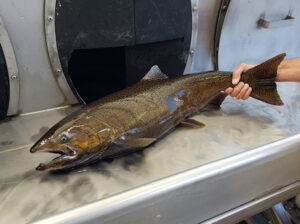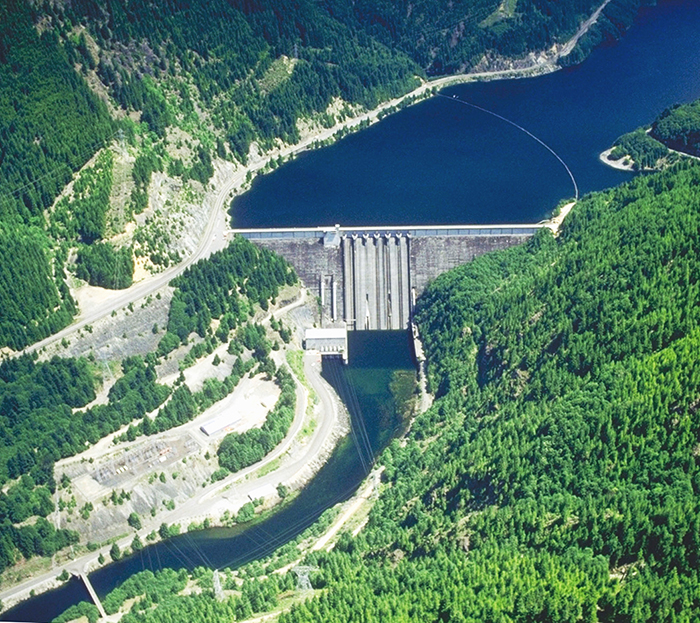Reporter for The Canyon Weekly
The U.S. Army Corps of Engineers is steaming toward another report on how to achieve cooler water temperatures and better fish passage at Detroit Lake and other reservoirs in the Willamette River Basin.
A new environmental impact statement and record of decision are due in 2025, said Jeffrey Henon, a public affairs specialist in the Corps’ Portland office.
The goal of the project is to improve threatened winter steelhead and spring Chinook salmon stocks in the Willamette basin, and the new EIS is intended to be a response to a 2008 biological opinion and court order.
Yes, 2008. This project has been grinding away for a bit as well as going through a bit of a reboot.
Instead of Corps officials working specifically on Detroit, the new EIS reflects a broader initiative that covers the entire 13-dam system.
Earlier proposals for Detroit included consideration of building a massive tower near the dam to address the water temperature issue and a giant weir to move fish around the dam. Such structures also are part of the mix of alternatives in the revised plan, but the plan is for a lake level that will make it easier for recreation interests to operate at Detroit Lake.
The project aims to improve conditions for ESA-listed fish while providing flexibility for the USACE to meet water demands for fish and wildlife, water supply, hydropower generation, and recreation.

The process is of keen interest in the Santiam Canyon because of the tourism value of Detroit Lake. If solutions to the fish passage/temperature challenges require lowering the lake level to a significant degree, the region’s economy will suffer.
The Detroit community participated in a region-wide spate of criticism of the project during 2017 and 2018, when explosive public sessions were held in Gates and Stayton. At those meetings Detroit and Santiam Canyon interests felt they weren’t being listened to amid Corps proposals that might have severely limited lake use for perhaps as long as two years.
Marion County Commissioner Kevin Cameron was on hand for those tumultuous meetings and he has been working with Detroit Councilor Denny Nielsen and other local Detroit stakeholders on an informational committee that is meeting to discuss the project.
“The last I had heard was the Corps was still planning on the installation of the water cooling tower and some type of fish collection facility,” Cameron told The Canyon Weekly. “They said they will be doing it ‘in the wet,’ thus not drawing down the reservoir.”
In the wet means much of the work will be done by divers with the lake remaining at high levels. Such an approach takes longer and is more expensive.
That said, the project does not yet have any dedicated funding, Henon said. Earlier iterations of the project were estimated to cost in the $500 million range with completion set for 2028.
Current timelines call for a temperature control tower to be completed by 2031 and downstream fish passage work to be completed by 2035.
The public comment period on the basin’s EIS/ROD documentation ended with a public meeting Jan. 12 in Stayton.
Nielsen told The Canyon Weekly that the Detroit-area informational group is discussing “how we can help the Corps.”
Nielsen, like a lot of stakeholders in the Canyon, remains skeptical of the project.
“The modeling they are using is decades old,” the councilor said, “and we’re concerned about whether they are reflecting current weather and climate change issues.”
Amid the narrow focus of what is the best result for Detroit the Corps also is dealing with chaos elsewhere in the basin.
The water level was drawn down at Green Peter Reservoir on the South Santiam River near Sweet Home and the move has had a series of ripple effects.
Thousands of kokanee salmon died and water quality was affected in Sweet Home and other sections of eastern Linn County as well as in the Albany-Millersburg area.
According to the Oregon Department of Fish and Wildlife the fish died from barotrauma, a condition caused by a rapid pressure reduction as fish pass from deep below the surface on one side of the dam to the other side near the surface level. Among divers, this decompression effect is known as “the bends.”
Kokanee salmon, which are not endangered, are particularly sensitive to the pressure change.
At its Dec. 19 meeting in Albany the Linn County Board of Supervisors discussed the possibility of filing a formal complaint with federal agencies about the turbidity levels in the South Santiam River due to the drawdown of Green Peter.
KEY OBJECTIVES
Here is a look at top goals for the Corps of Engineers fish project in the Willamette Valley:
1. Greater flexibility in water management (refill, drawdown timing, etc.).
2. Create nature-based structures that help prevent bank erosion.
3. Greater flexibility in hydropower production.
4. Increase ESA-listed fish passage survival at dams.
5. Improve water management during the conservation season to benefit ESA-listed fish and other project purposes.
6. Improve water quality to benefit ESA-listed species.
7. Reduce spawning and rearing habitat competition caused by hatchery fish






